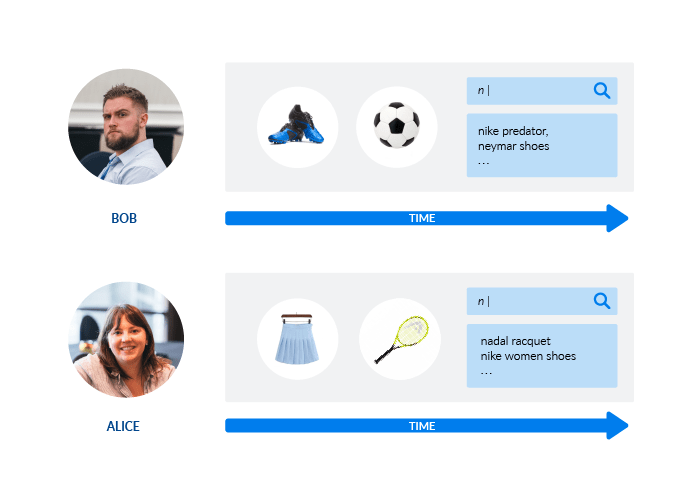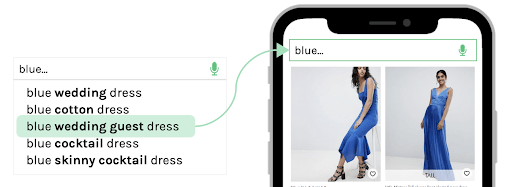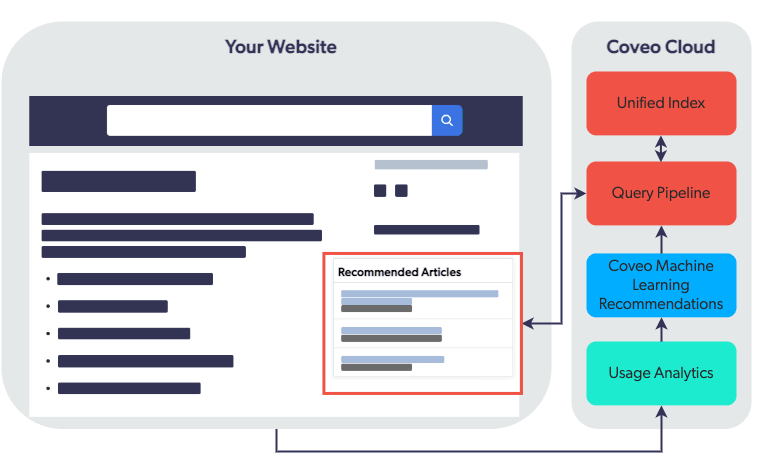Creating a clean, complete product catalog for your ecommerce site is like setting up a neat, orderly storefront. You carefully scoped out real estate, chose the location you thought had good foot traffic, and now you’ve organized your products to make it easy for customers to find.
But is this enough? Customers can wander in and out of your store, much in the same way they can wander in and out of your website.
Consider the customer journey: from arriving on your site, browsing, reading reviews, comparing products, to (hopefully) adding to cart and clicking the “purchase” button. Throughout all of this, your customers expect you to anticipate the next piece of information, the next action, and the next step that they need on that journey.
This is why stores have store clerks; this is also why your ecommerce store needs machine learning. Take our automatic relevance tuning model, or ART, as an example; it’s powered by behavioral data generated by shoppers as they navigate and click on different items in your store.
Here’s how clean product data and machine learning can enhance your customer’s online shopping experience.
Organized Catalog = Comprehensible Customer Data
Any good shop lives or dies based on growing a loyal customer base. And this is based on getting to know your customers. For ecommerce, that means collecting, understanding, and using the information your customers provide to you.
An in-person store clerk doesn’t know these folks right off the bat. Instead they’ll chat with these new customers, or observe what they interact with in the store to get a better understanding of their likes and dislikes. Online, you don’t often have the opportunity to chat with your customers. In fact, about 70% of online traffic is what we’ve dubbed “cold start shoppers.” These are shoppers who, whether they’re truly new to your site, or their cookies have expired, or they’re visiting incognito, you don’t have any historical data for.
Gartner reports that while companies globally are spending about 14% of their ecommerce budgets on personalization, 69% aren’t getting positive results. Without history, what can you base personalization on?
It starts with your product catalog. Just like customers moving through a store, picking one item up over another or interacting with specific displays, a store clerk gains insight into what they might like. Machine learning can use behavioral data and the “wisdom of the crowd” in the same way to provide intent-driven personalization, even within a single session.
More wisdom means the model is fed more insights, providing an ever-evolving amount of personalization even for first time shoppers. This is the beauty of combining machine learning with clean product data—you can’t draw insights from a messy website.
Personalize for People, with Intent
Through an informal chat, an in-person store clerk can learn a lot about a person. For instance, specifically what they’re searching for, or sometimes a few ideas if the shopper isn’t sure. Maybe they’re looking to invest in a new pair of soccer cleats before their team’s next season picks up, or they’re in the market for books similar to Merlin Sheldrake’s Entangled Life.
By combining the ‘wisdom of the crowd’ and in-session data via machine learning, your ecommerce site can offer the most popular products for a specific time period, location, or time of year—and any combination thereof.
As the machine learning model ingests information—whether it be existing product information from your catalog, historical information from authenticated users that have registered on your site, or in-session information gleaned from users clicking around—it can provide increasingly strong recommendations that are further improved over time. It does this using an ML model we call prod2vec.

An east-coast U.S. shopper looking at coats during December is thinking of incoming winter snows. A shopper in Australia during the same time of year probably isn’t thinking about coats at all: they’ll probably want a bathing suit!
And all of this is just to start. You can also show other popular products, and as a potential buyer starts to click around, begin to build on their user experience using the behavioral data they’re generating—and if you do this well, the shopper won’t even notice. This is due to their experience being seamlessly tailored to them, in real time. They’ll just enjoy your website more!
Predict Relevant Results, With Little Input
When you look around online, where do you often start? With the search box!
This is where machine learning can step in again to provide a dose of personalization. Whether a customer knows exactly what they’re looking for or not, returning results is key. But not just any results. Relevant results.
Say a customer is searching for lotion—CeraVe brand, specifically. Unfortunately, you don’t carry that specific brand. Is it enough to throw all of the other toiletry items you’ve got at them instead, hoping they’ll like something you show them? Of course not.

Because the machine learning model has ingested your clean product catalog data, it can provide specific recommendations related to the search that customer just did. It’s not going to show them shampoo, or skin toner, or even lotion for extra dry skin. Perhaps that shopper was looking at bathing suits and towels—with this information, the ML model can conclude that either the shopper would like tanning lotion or sunscreen.
You can even provide this level of personalization for our above-discussed cold-start shoppers—
This intent-driven personalization takes into account not just the keywords the customer used, but also their intent. Over time, as machine learning ingests more data through more interactions, it can tweak the model to provide results based on the ‘wisdom of the crowd.’
And your clean product catalog provides the necessary data that makes all of this possible. In the end, the most relevant—thus most likely to be purchased—items rise to the top of your shoppers’ search pages.
Fill Product Pages With Relevant Content
A standardized product catalog means product pages are the store displays of your ecommerce website—tidy, clearly labeled, with crisp photos and other insights that ease your customer’s decision-making process.
You can further enhance your product pages with additional information, which can be curated depending on the shopper viewing the page. You can even pull rich content from different sources, using a unified index that allows for disparate content to be used in new places. A new customer might see knowledge articles that give a deep dive on a product’s various functions, or unique situations or events where their product will come in handy.
A former customer might come back looking for a solution to what they don’t know is an already well-known issue, and be presented with support documentation that’s already popular with other customers.

Other potential content you could show are training videos hosted on YouTube that you or other customers have created, or community posts that let customers share their own knowledge and experiences.
Within the Coveo Relevance platform, this content curation is provided by Content Recommendations powered by machine learning. Take a website that sells smart pedometers, for example. A product page can display a number of videos that help a shopper get the most out of their purchase—enhancing their experience and fostering a positive relationship with your brand.

Clean Catalog Means Better Recommendations
More than 90% of shoppers reported that they would return to a site with a personalized digital experience that tailors product recommendations based on their previous shopping habits. McKinsey actually estimated that 35% of what consumers purchase on Amazon and 75% of what they watch on Netflix come from product recommendations.
Essentially, intelligent product recommendations have the potential to serve as an effective stand-in for your friendly shop assistant at a time when digital experiences are quickly becoming the norm, and will only continue to increase in use and preference. With clean product data and an organized catalog, it’s easier for both you and your customers to discern the relationships between products—which makes it easier to provide relevant product recommendations.
And product recommendations don’t have to be isolated solely to the product pages they relate to: you can put product recommendations on the homepage, before or after the shopping cart page, or the no results page, as just a few suggestions.
Dig Deeper
Ecommerce has grown leaps and bounds during the pandemic, but have their customer experiences improved as well? Find out what makes a relevant ecommerce experience.
Are you dreaming of a new (better?) search solution for your site, but not sure where to start? We’ve got six questions to ask yourself and vendors when evaluating options on the market. If you’re curious about the Coveo Relevance platform, try out a demo!

